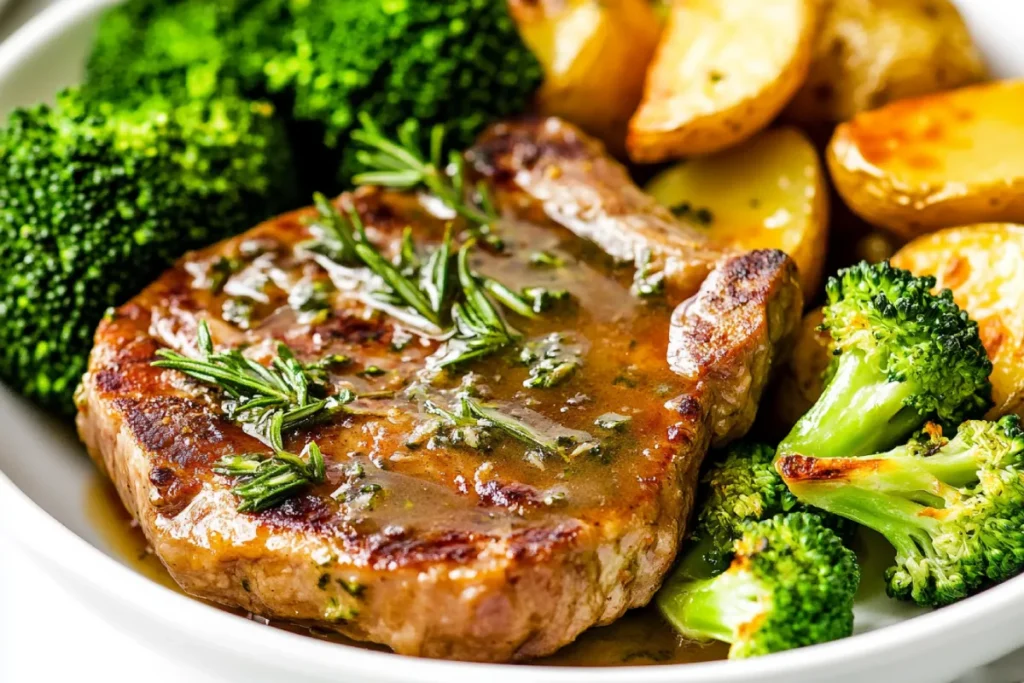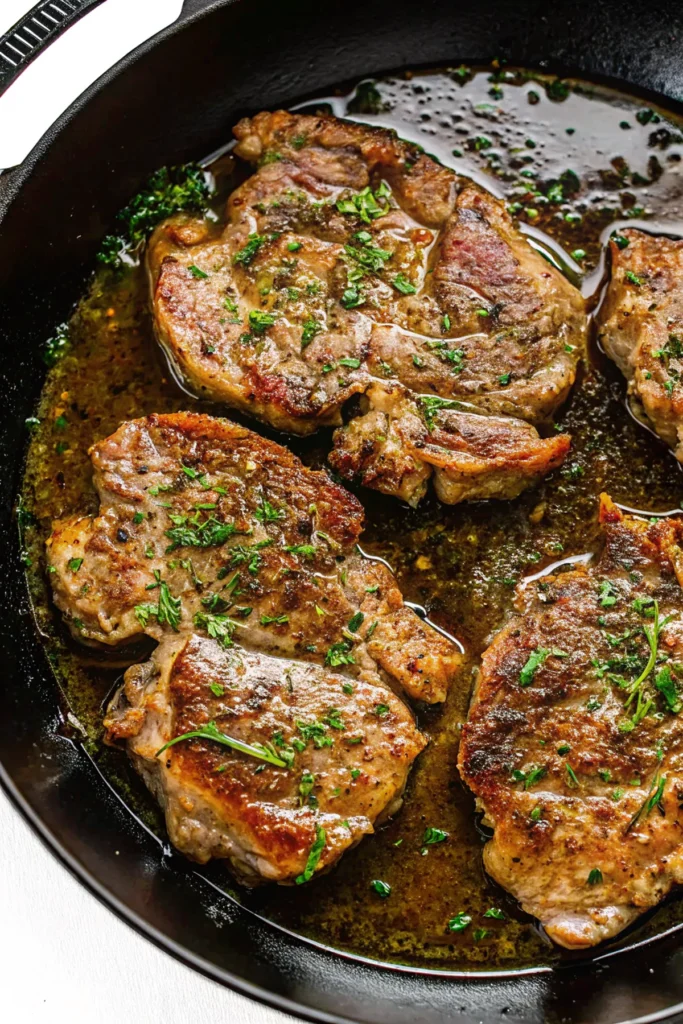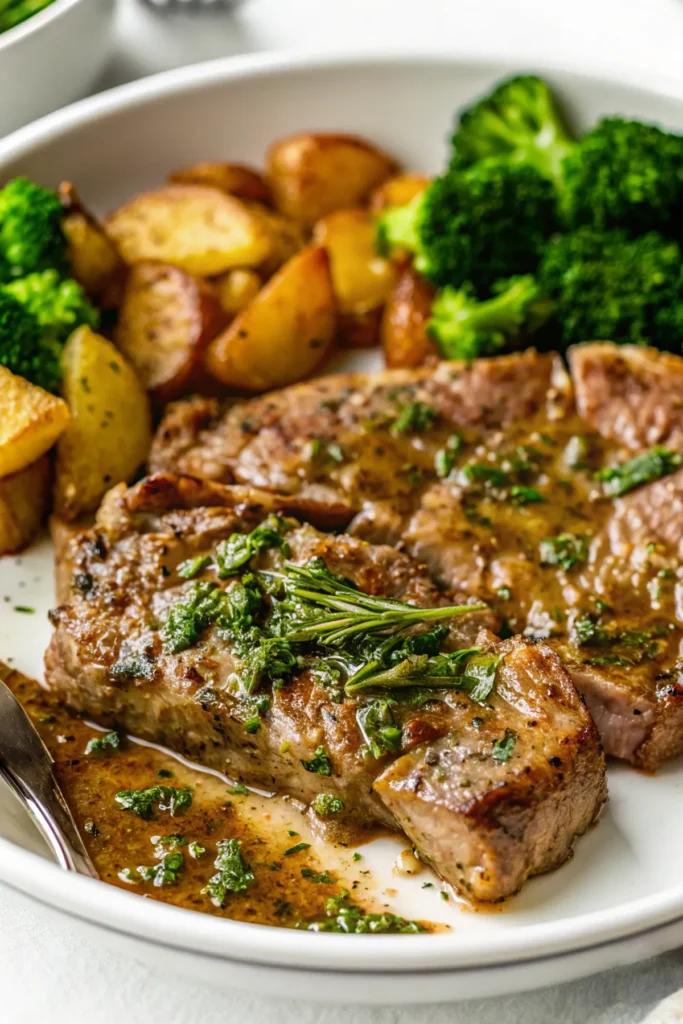Are pork steaks the same as pork chops? Okay, let’s be real for a second. If you’ve ever stood in the meat section of a grocery store wondering if pork steaks and pork chops are the same thing, you’re not alone. (I’ve totally been there, staring at labels like I’m trying to crack a code.) However, trust me, they’re not the same! Sure, they’re both cuts of pork, but the differences go way beyond just the name on the package.

In this post, I’ll break it all down for you—what makes a pork steak a pork steak, how it’s different from a pork chop, and even which one works best for certain recipes. Moreover, I’ll answer some common questions about these cuts and share cooking tips that’ll have you saying, “Wow, I made that!”
What Are Pork Steaks?
Let’s start with the basics. Pork steaks, also called “blade steaks,” come from the pork shoulder (also known as the Boston butt). This cut is fattier and has more marbling, which means flavor is practically built-in.
Key Features of Pork Steaks:
- Cut from the shoulder: This part of the pig is naturally flavorful and juicy.
- Thicker texture: Pork steaks are often sliced thicker, making them hearty and filling.
- Affordable: They’re usually cheaper than pork chops, which is a win if you’re feeding a crowd or on a budget.
- Cooking methods: These beauties are ideal for grilling, braising, or pan-frying. The fat keeps them juicy even during longer cooking times.
Fun fact: In the Midwest (looking at you, St. Louis), pork steaks are a BBQ favorite. Smother them in sauce, cook them low and slow, and you’ve got yourself a crowd-pleaser.

What Are Pork Chops?
Now, pork chops are like the classic movie stars of the pork world—always in the spotlight. These cuts come from the loin, which runs along the back of the pig, and they’re leaner than pork steaks.
Key Features of Pork Chops:
- Cut from the loin: This is a leaner area, so chops tend to have less fat.
- Variety of cuts: You’ve got bone-in chops, boneless chops, thick-cut chops—you name it.
- Tender but tricky: Since they’re leaner, they can dry out quickly if overcooked (nobody wants a tough pork chop, trust me).
- Cooking methods: Pork chops are great for quick-cooking methods like pan-searing or baking. They’re also perfect for breading and frying if you’re feeling fancy.
Pork Steaks vs. Pork Chops: What’s the Real Difference?
Okay, so here’s the deal: the main difference lies in where the cuts come from on the pig and their fat content.
| Feature | Pork Steaks | Pork Chops |
|---|---|---|
| Cut From | Shoulder (Boston butt) | Loin (back area) |
| Fat Content | High (more marbling) | Low (leaner) |
| Flavor | Rich, juicy, bold | Mild, slightly sweet |
| Cooking Time | Longer (due to fat content) | Shorter (quicker cooking) |
| Price | Affordable | Moderate to pricey |
Texture and Flavor
Pork steaks are fatty and flavorful. The marbling melts into the meat as it cooks, which means you’re left with a juicy, tender bite every time. Pork chops, on the other hand, are leaner and more delicate in flavor. They’re great for light, simple dishes but require more attention to avoid drying out.
When to Choose Pork Steaks
- BBQ Nights: Pork steaks love a good slathering of BBQ sauce. Cook them low and slow for that fall-apart tenderness.
- Budget-Friendly Meals: Need something tasty without breaking the bank? Pork steaks are your go-to.
- Rich, Hearty Dishes: Braise them in a tomato-based sauce or stew, and you’ve got comfort food for days.

When to Choose Pork Chops
- Quick Dinners: Got 20 minutes? Pan-sear a pork chop, add a side of veggies, and boom—dinner’s ready.
- Lean Protein Options: Watching your fat intake? Pork chops fit the bill.
- Classic Recipes: Breaded and fried pork chops are a nostalgic favorite. Pair them with mashed potatoes, and it’s basically Sunday dinner at grandma’s.
Cooking Tips for Pork Steaks and Pork Chops
Pork Steaks:
- Marinate for flavor: While they’re already flavorful, a good marinade can take them to the next level. Think soy sauce, garlic, and a touch of honey.
- Cook low and slow: For super tender pork steaks, braise them or grill them over indirect heat.
- Don’t skip the fat: That fat cap? It’s gold. Let it render down for extra flavor.
Check out our Pork Steak Recipe for step-by-step instructions.
Pork Chops:
- Brine them: A quick brine can keep your pork chops juicy. Just mix water, salt, and a little sugar, and soak the chops for 30 minutes.
- Use a meat thermometer: Pork should hit an internal temp of 145°F. Trust me, guessing leads to overcooking.
- Rest before slicing: Let them sit for 5 minutes after cooking to lock in the juices.
My Personal Take: The Winner in My Kitchen
If I had to choose, I’d go with pork steaks for their unbeatable flavor. There’s just something about that juicy, melt-in-your-mouth texture that makes them a superstar at the dinner table. But hey, pork chops have their time and place too—like when I’m in a hurry or craving something light.
So, whether you’re team pork steak or team pork chop, one thing’s for sure: there’s no wrong choice when it comes to cooking up some delicious pork.
Are Pork Steaks and Pork Chops Interchangeable?
A lot of folks wonder if you can use pork steaks and pork chops interchangeably in recipes. However, while they might look similar at first glance, their cooking behavior is completely different. Pork steaks, with their higher fat content, can handle longer cooking times without drying out. Moreover, they’re perfect for recipes that require braising or slow cooking, such as a hearty pork steak stew or saucy BBQ dishes.
Pork chops, on the other hand, are better suited for quick cooking methods. For example, think pan-seared chops with a light lemon butter sauce or grilled chops topped with a fruity salsa. Additionally, swapping one for the other can lead to unexpected results—like a dry chop or a greasy steak. In fact, understanding the differences between these cuts can save you a lot of mealtime frustration and ensure the dish turns out as delicious as planned.
Why Do Pork Steaks Have More Flavor?
If flavor is what you’re after, pork steaks are tough to beat. The extra marbling of fat in the shoulder cut gives pork steaks a rich, bold taste that you simply won’t find in the loin. Moreover, the fat renders down during cooking, naturally basting the meat from the inside out and creating an irresistible juiciness. This is exactly why pork steaks often take center stage at backyard cookouts—they absorb smoky flavors and spices exceptionally well, making them a fan favorite.
However, pork chops, while milder in taste, have their own appeal. The leaner meat provides a gentle sweetness that pairs beautifully with light seasoning or marinades. Additionally, a straightforward herb rub can amplify the delicate flavor of a pork chop without overpowering it, making it a great option for a quick and sophisticated dish.
Regional Favorites
Did you know that the preference for pork steaks or pork chops often depends on where you live? In fact, in the Midwest, pork steaks are a summertime favorite. They’re grilled, smoked, or even prepared “St. Louis-style” with a generous slathering of tangy BBQ sauce. However, pork chops are beloved nationwide, appearing in everything from quick weeknight meals to elegant holiday spreads.
Moreover, this regional divide isn’t solely about tradition—it’s also influenced by what’s available locally. In certain areas, pork steaks may not even be an option at your grocery store, making pork chops the more convenient choice. Additionally, here’s a pro tip: if you’re unable to find pork steaks, ask your butcher to carve a pork shoulder roast into thick slices for you. Problem solved!
Are Pork Steaks Just Pork Chops with a Different Name?
Let’s clear up another common myth: pork steaks aren’t just pork chops rebranded with a fancier name. They come from completely different parts of the pig, which impacts their flavor, texture, and fat content. Think of it like this: comparing pork steaks to pork chops is like comparing ribeye to filet mignon. Both are delicious, but they’re tailored for different tastes and cooking styles.
So, next time someone asks you, “Are pork steaks just pork chops?” you can confidently say, “Nope, and here’s why!” Then hit them with all the juicy details you’ve learned.
FAQs
Are Pork Steaks the Same as Pork Chops?
No, pork steaks and pork chops are different cuts. Pork steaks comes from the shoulder, while pork chops are cut from the loin along the pig’s back.steaks are fattier and richer in flavor, ideal for slow cooking or grilling. Pork chops are leaner and cook faster, making them perfect for quick meals.
Why Are Pork Steaks So Cheap?
Pork steaks are cheaper because they come from the shoulder, a less premium cut compared to the loin. The shoulder has more connective tissue and fat, which takes longer to cook. This makes it less expensive than the tender, lean cuts used for pork chops.
What Cut of Meat Are Pork Steaks?
Pork steaks are sliced from the pork shoulder, also called the Boston butt. This cut is marbled with fat, giving it a juicy, flavorful profile that stands up well to grilling, braising, or slow cooking.
What’s the Difference Between Chops and Steaks?
The main difference is where they’re cut from. Pork chops come from the loin and are leaner, while pork steaks are from the shoulder and have more fat. This affects their texture, flavor, and cooking time. Chops are great for quick meals, while steaks shine in hearty, slow-cooked dishes.
Final Thoughts
Now that you’re familiar with the difference between pork steaks and pork chops, the decision is entirely yours. Are you craving rich, juicy flavor with a hearty texture? Pork steaks are the perfect choice. On the other hand, if you’re after something lighter and quicker to cook, pork chops are an excellent option. Either way, you’re in for a satisfying meal.
Additionally, the next time you’re browsing the meat section, skip the guesswork and choose with certainty. In fact, why not grab both and try them out in different recipes? Your taste buds will definitely appreciate the variety!

1 thought on “Are Pork Steaks Just Pork Chops? A Food Lover’s Guide to Understanding the Difference”